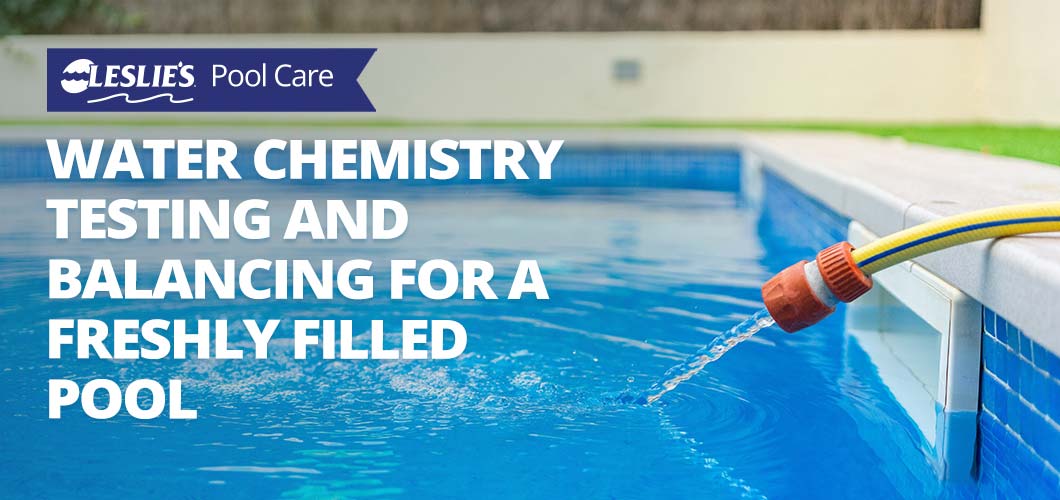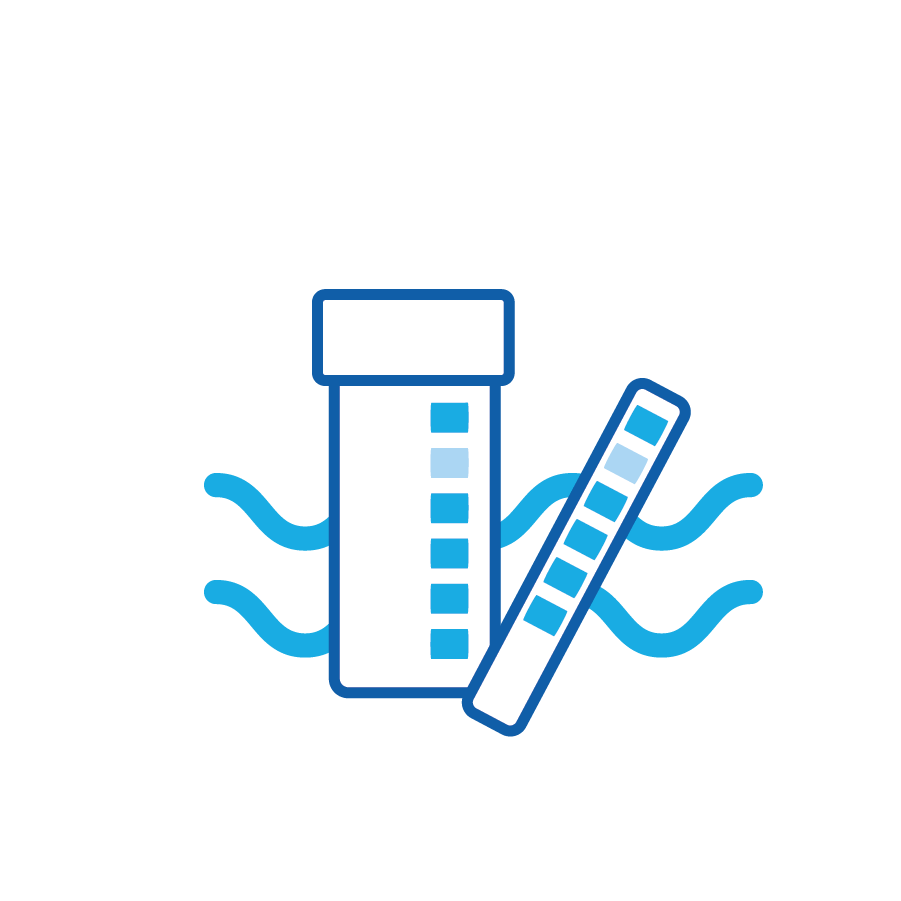
Water Chemistry Testing and Balancing for a Freshly Filled Pool
Whether you’re filling a brand new pool, or refilling a recently drained pool, it’s important to establish balanced water chemistry as soon as possible. Proper water chemistry promotes the longevity of pool equipment and surfaces, preventing corrosion and damage. Additionally, balanced water enhances the effectiveness of sanitizers, optimizing their ability to control bacteria and algae. So let's explore the basics of attaining and sustaining proper pool water chemistry after filling.
Types of Water to Fill a Pool
As a general rule, most pool experts recommend that you replace pool water every 3-5 years, depending on the water conditions. There are three main methods in which you can source your pool water from.
Tap Water

Well Water

Water Delivery Service

Tap Water
If your property gets city tap water, using a hose to fill your pool may significantly raise your water bill. Filling an average-sized 15,000-gallon swimming pool typically takes approximately 24-48 hours. Before initiating the pool-filling process with tap water, check for any water shortages or mandatory rationing in your state or region. Check your area's water quality report to understand existing conditions, including pH, Total Alkalinity, Calcium Hardness, and other chemicals and minerals.
Well Water
If you've got well water on your property, you can use it to fill up your pool, but one challenge is making sure you've got enough of it. It might take around 72 hours to fill up a regular 15,000-gallon pool with well water. Also, well water could have higher levels of calcium, nitrates, iron, sulfur, and other minerals, which can cause dramatic discoloration, staining on pool surfaces, and interfere with the effectiveness of sanitizers. Using an in-line hose filter is a good way to get rid of some of those metals and minerals. Note that if well water has high nitrate levels, opting for a water delivery service may be the best choice.
Water Delivery Service
In water-scarce or drought-prone areas, pool owners may need water delivered to fill their pools. In addition, some areas may have strict regulations on water consumption due to environmental concerns. It’s important for pool owners to be aware of their local water regulations, restrictions, and conditions in their specific location. The water provided is typically tap water and must be treated accordingly after filling the pool. Though costly, using a water delivery service may be the sole option in many cases.
NOTE: If you are filling a newly resurfaced pool, follow the manufacturer’s or builder’s start-up recommendation. A sequestering agent is recommended for all surface types to prevent staining.
BONUS TIP: Draining the water completely can put a pool at risk of irreversible damage. Hydrostatic pressure, which refers to the groundwater pressure around and under your pool, can result in “pool floating,” causing shifting and cracking in the floors and walls of gunite and fiberglass pools. For a vinyl pool, the liner may contract and end up tearing when refilled. Consult a pool professional before fully draining.
Testing and Balancing the Water

Proper water chemistry is essential if you want to prevent issues like algae growth, cloudy water, staining, and corrosion in a freshly filled swimming pool. To begin this process, use a water test kit or test strips to determine the status of your pool water chemistry. Then, use the proper balancing chemicals as necessary to adjust the levels according to this list:
- Total Alkalinity: 80-120 ppm
- pH: 7.4-7.6
- Calcium Hardness: 200-400 ppm
- Cyanuric Acid: 30-50 ppm
Total Alkalinity
Start by addressing adjustments to Total Alkalinity (TA) as it directly affects pH levels. If your TA is below 80 ppm, add Leslie’s Alkalinity Up or Leslie’s Soda Ash depending on the pH level. Conversely, if the TA exceeds 120 ppm, use Leslie’s Dry Acid or muriatic acid to bring the levels down. For fiberglass, vinyl liner, or painted pools, we recommend using Dry Acid.
pH
Chlorine functions most effectively when the pH is between 7.2-7.4, but once it drops below 7.0, the water turns acidic and corrosive. The lower the pH, the more destructive it becomes. On the other hand, when the pH level surpasses 8.0, chlorine’s killing power decreases and the water becomes basic, leading to cloudiness and scale deposits. To maintain an optimal pH level, use the correct pH adjuster. Leslie’s Dry Acid or muriatic acid will lower the pH, and Leslie’s Soda Ash will raise pH levels.
Calcium Hardness
Ideal Calcium Hardness levels range from 200-400 ppm. Insufficient calcium, or soft water characterized by levels below 120 ppm, may draw calcium from pool surfaces, leading to erosion and damage. High levels of Calcium Hardness, or hard water, can cause cloudy pool conditions, such as scaling. When it comes to balancing Calcium Hardness, it’s much easier to raise it than to lower it. Adding Leslie’s Hardness Plus will bring the levels up. But if Calcium Hardness exceeds 600 ppm, consider partially draining and refilling the pool to lower levels.
Cyanuric Acid
Cyanuric Acid (CYA), commonly referred to as chlorine stabilizer or pool conditioner, plays a crucial role in stabilizing the chlorine levels in your pool. Without Cyanuric Acid, the chlorine in your pool would rapidly degrade when exposed to the sun’s ultraviolet rays. Since fresh water does not contain Cyanuric Acid, this chemical must be added to an outdoor chlorinated pool. Raise the level to 30 ppm by adding Leslie’s Conditioner or liquid Instant Conditioner Plus.
Other Things to Consider
In addition to the above mentioned key chemicals, keep watch of the Total Dissolved Solids (TDS), Metals, and Phosphates present in your pool water. The presence of any of these three chemicals can compromise the integrity of the water chemistry and cause cloudiness, staining, erosion, and foul odors. TDS is a measurement of all the solids dissolved in your pool and should have a reading of 0-2500 ppm. Unfortunately, TDS cannot be eliminated, so if the reading is above 2500 ppm, then it’s best to consider partially draining and refilling the pool. When it comes to metals and phosphates present in your pool, it’s best that the levels are at zero or in very small quantities. To keep your metal content low, use Leslie’s NoMetal Metal Stain Remover. If phosphates are present in your pool, adding a phosphate remover like Leslie’s NoPhos will help.
Whatever the situation you may be in, there’s one thing to remember: maintaining balanced water chemistry is necessary to keep your pool clean, safe, and beautiful. Regularly maintaining and testing your pool's water chemistry is crucial for ensuring the ongoing health and safety of swimmers.
If you still have questions about specific aspects of water chemistry, we can help! Stop by your local Leslie’s to speak with one of our certified pool experts, or to have us analyze all 10 aspects of your pool water chemistry with a free AccuBlue water test. Once the test is complete, you'll receive a printout with a water quality score. If any aspects of your pool's chemistry are out of balance, you'll receive detailed instructions on how to fix them.